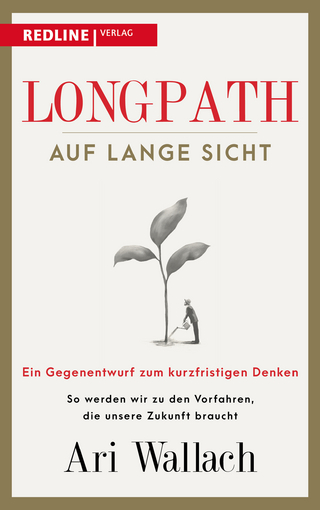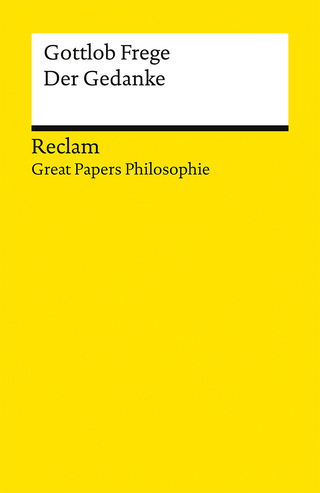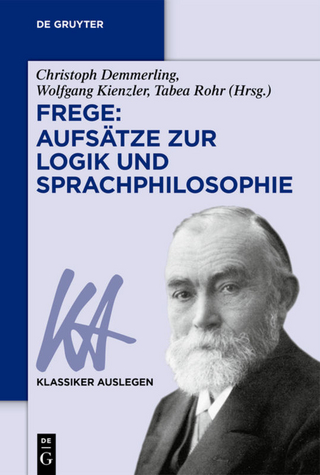
The Critical Thinking Toolkit
Wiley-Blackwell (Verlag)
978-0-470-65996-0 (ISBN)
Takes an expansive approach to critical thinking by exploring concepts from other disciplines, including evidence and justification from philosophy, cognitive biases and errors from psychology, race and gender from sociology and political science, and tropes and symbols from rhetoric
Follows the proven format of The Philosopher’s Toolkit and The Ethics Toolkit with concise, easily digestible entries, “see also” recommendations that connect topics, and recommended reading lists
Allows readers to apply new critical thinking and reasoning skills with exercises and real life examples at the end of each chapter
Written in an accessible way, it leads readers through terrain too often cluttered with jargon
Ideal for beginning to advanced students, as well as general readers, looking for a sophisticated yet accessible introduction to critical thinking
Galen Foresman is an Associate Professor of Philosophy at North Carolina Agricultural and Technical State University, USA. His research interests include ethics, philosophy of punishment, philosophy of religion, and philosophy as it applies to pop culture. He is the author of several book chapters and the editor of Supernatural and Philosophy (Wiley Blackwell, 2013). Peter S. Fosl is Professor and Chair of Philosophy and Chair of Philosophy, Politics, and Economics at Transylvania University, USA. A David Hume Fellow at the University of Edinburgh, his research interests include skepticism and the history of philosophy, as well as, topics in politics and religion. He is author or editor of many books, including The Big Lebowski and Philosophy (Wiley Blackwell, 2012), The Philosopher's Toolkit (second edition, Wiley Blackwell, 2010), and The Ethics Toolkit (Wiley Blackwell, 2007). He is also Editor-in-Chief of the Open Access academic journal, CogentOA: Arts & Humanities. Jamie Carlin Watson is Assistant Professor of Philosophy at Broward College, USA. His primary research is in the social epistemology of epistemic advantage and expertise, especially as they influence testimony in practical fields such as medicine and business. He has published articles in journals such as Episteme and Journal of Applied Philosophy, and he is the co-author of Critical Thinking: An Introduction to Reasoning Well (second edition, 2015), What's Good on TV? Understanding Ethics Through Television (Wiley Blackwell, 2011), and Philosophy Demystified (2011).
Acknowledgments xv
Introduction 1
The Very Idea of Critical Thinking 1
Critical thinking in the formal and empirical sciences 2
Critical thinking, critical theory, and critical politics 4
Critical thinking, finitude, and self-understanding 5
Using this book 5
1 Basic Tools for Critical Thinking about Arguments 7
1.1 Claims 7
Beliefs and opinions 8
Simple and complex claims 9
Truth functionality 10
1.2 Arguments 11
Logic vs. eristics 12
Arguments vs. explanations 12
1.3 Premises 13
Enthymemes 14
Identifying premises 14
1.4 Conclusions 16
Argument structure 16
Simple and complex arguments 16
Identifying conclusions 17
2 More Tools for Critical Thinking about Arguments 19
2.1 Deductive and Inductive Arguments 19
Deduction 20
Induction 21
2.2 Conditional Claims 22
Necessary and sufficient conditions 23
Biconditional claims 25
2.3 Classifying and Comparing Claims 26
Comparing claims 26
Classifying single claims 28
2.4 Claims and Definitions 29
Lexical, stipulative, ostensive, and negative definition 30
Extension and intension 30
Generic similarities and specific differences 31
Definiens and definiendum 31
2.5 The Critical Thinker’s “Two Step”: Validity and Soundness/Cogency and Strength 32
Structure before truth 33
2.6 Showing Invalidity by Counterexample 35
3 Tools for Deductive Reasoning with Categories 39
3.1 Thinking Categorically 39
Types and tokens 39
3.2 Categorical Logic 40
Quality, quantity, and standard form 40
Venn diagrams and the meaning of categorical claims 42
Distribution and its implications 44
Existential import 45
3.3 Translating English Claims to Standard Form 46
Implicit quantifiers 46
Individuals 47
Getting the verb right 47
Adverbials 48
Trust your instincts 50
A caveat 50
3.4 Formal Deduction with Categories: Immediate Inferences 50
Equivalences 51
Conversion 52
Contraposition 53
Obversion 56
The Aristotelian and Boolean Squares of Opposition 58
3.5 Formal Deduction with Categories: Syllogisms 63
Categorical syllogisms 64
Major and minor terms 64
Mood and figure 65
The Venn diagram test for validity 66
Five easy rules for evaluating categorical syllogisms 69
Gensler star test 70
4 Tools for Deductive Reasoning with Claims 72
4.1 Propositional vs. Categorical Logics 72
Translating claims into propositional logic 73
Truth tables for claims 76
Testing for validity and invalidity with truth tables 78
Indirect truth tables 79
Strange validity 82
4.2 Common Deductively Valid Forms 83
Modus ponens 83
Modus tollens 84
Hypothetical syllogism 86
Disjunctive syllogism 86
Constructive and destructive dilemmas 87
4.3 Equivalences 90
Double negation 90
Tautology 91
Commutativity 91
Associativity 92
Transposition 92
Material implication 93
Material equivalence 93
Exportation 94
Distribution 95
DeMorgan’s Law 95
4.4 Formal Deduction with Forms and Equivalences 96
Three simple rules 97
4.5 Common Formal Fallacies 101
Affirming the consequent 101
Denying the antecedent 103
Affirming a disjunct 104
5 Tools for Detecting Informal Fallacies 107
5.1 Critical Thinking, Critical Deceiving, and the “Two Step” 107
5.2 Subjectivist Fallacy 109
5.3 Genetic Fallacies 112
5.4 Ad Hominem Fallacies: Direct, Circumstantial, and Tu Quoque 113
Direct 114
Circumstantial 115
Tu quoque 118
5.5 Appeal to Emotions or Appeal to the Heart (argumentum ad passiones) 120
Appeal to pity (argumentum ad misericordiam) 120
Appeal to fear (argumentum ad metum) 122
Appeal to guilt 122
5.6 Appeal to Force (argumentum ad baculum) 124
5.7 Appeal to Ignorance (argumentum ad ignorantiam) 125
Negative evidence and no evidence 126
5.8 Appeal to Novelty (argumentum ad novitatem) 127
5.9 Appeal to the People (argumentum ad populum) 128
Bandwagon 128
Appeal to snobbery 129
Appeal to vanity 129
5.10 Appeal to Unqualified Authority (argumentum ad verecundiam) 132
5.11 Fallacy of Accident 135
5.12 False Dilemma 137
5.13 Semantic and Syntactic Fallacies 138
Ambiguity, two types: lexical and syntactic 138
Vagueness vs. ambiguity 139
Vagueness, two types: degree and context 139
Equivocation and fallacious amphiboly 140
5.14 Begging the Question (petitio principii) 143
5.15 Question-Begging Sentences 144
5.16 Missing the Point (ignoratio elenchi) 145
5.17 Fallacy of Composition 146
5.18 Fallacy of Division 148
5.19 Is-Ought Fallacy 149
5.20 Appeal to Tradition 152
5.21 Quoting Out of Context 153
5.22 Red Herring 158
5.23 Straw Man and Fidelity 159
5.24 Hasty Fallacization 161
5.25 A Brief Argument Clinic 162
Context 162
Charity 162
Productivity 163
6 Tools for Critical Thinking about Induction 166
6.1 Inductive vs. Deductive Arguments Again 166
6.2 Analogies and Arguments from Analogy 167
Criticizing analogies 168
6.3 Fallacies about Causation 170
Post hoc ergo propter hoc 170
Correlation is not always causation 171
Cum hoc ergo propter hoc 172
Neglecting a common cause 172
Oversimplified and contributing causes 174
Proximate, remote, and intervening causes 175
6.4 Inductive Statistical Reasoning 177
Sampling: random and biased 177
Stratification 178
The gambler’s fallacy 179
Averages: mean, median, and mode 179
Distributions 180
6.5 Base Rate Fallacy 182
6.6 Slippery Slope and Reductio ad Absurdum 184
6.7 Hasty Generalization 188
6.8 Mill’s Five Methods 189
1. Method of Concomitant Variation 189
2. Method of Agreement 190
3. Method of Difference 191
4. Joint Method of Agreement and Difference 191
5. Method of Residues 192
7 Tools for Critical Thinking about Experience and Error 195
7.1 Error Theory 195
7.2 Cognitive Errors 197
Perceptual error 197
Memory 199
Stress and trauma 201
Projection 202
Transference 203
Confirmation bias 203
Denial 204
A little bit of knowledge … 204
The fallacy of false consensus 205
Naïve realism 205
7.3 Environment and Error 206
Obstruction and distraction 206
Duration 207
Motion 207
Distance 207
Context and comparison 208
Availability error 208
7.4 Background and Ignorance 209
7.5 Misleading Language 210
Suspect the negative 210
Implications and connotations 210
Damning by silence or understatement 211
7.6 Standpoint and Disagreement 211
The mosaic of truth 213
Incommensurability and deep disagreement 213
8 Tools for Critical Thinking about Justification 215
8.1 Knowledge: The Basics 215
Ordinary belief and hinge propositions 216
Plato’s definition of knowledge 216
Chisholm and belief 217
8.2 Feelings as Evidence 219
Some important features of all types of feelings 220
The importance of distinguishing sense experience from emotion 222
8.3 Skepticism and Sensory Experience 223
The weaknesses of sense experience as evidence 224
The strengths of sense experience as evidence 227
8.4 Emotions and Evidence 229
The weaknesses of emotional experience as evidence 229
The strengths of emotional experience as evidence 232
Tips for eliminating the negative effects of emotions 235
8.5 Justifying Values 237
The role of moral values in arguments 238
Four common views of value judgment 239
Tools for reasoning about moral values 241
8.6 Justification: The Basics 242
Justification and the problem of access 243
No reasons not to believe 244
Beyond a reasonable doubt 244
Obligation and permission to believe 245
8.7 Truth and Responsible Belief 246
Why is responsibility relevant to belief? 247
Responsibility without truth 247
8.8 How Does Justification Work? 248
Claims as evidence 248
Experience as evidence 249
8.9 A Problem for Responsible Belief 251
Gettier cases 252
Processes and probabilities as justification 253
Varieties of externalism 254
8.10 Evidence: Weak and Strong 256
Direct and indirect evidence 256
Testimony as evidence 258
Strong enough evidence? 259
Suppressed evidence fallacy 260
Four tips for recognizing “good” evidence 261
8.11 Justification: Conclusions 266
9 Tools for Critical Thinking about Science 271
9.1 Science and the Value of Scientific Reasoning 271
Useful, durable, and pleasant goods 271
An agreement engine 272
A path to knowledge 272
9.2 The Purview of Science 273
The limits of empiricism 274
What is and what ought to be 274
Different kinds of science 275
Critiques of science 279
9.3 Varieties of Possibility and Impossibility 280
Logical possibility 281
Physical possibility 281
Other types of possibility 282
9.4 Scientific Method 283
Causal explanation 283
Observation 284
Verification and falsification 285
Paradigms: normal and revolutionary science 288
9.5 Unfalsifiability and Falsification Resistance 289
Ad hoc hypotheses and the fallacy of unfalsifiability 290
Falsification and holism: hypothesis vs. theory 291
The “no true Scotsman” fallacy 291
9.6 Experiments and Other Tests 293
Controls and variables 293
Epidemiological studies 294
Personal experience and case studies 295
Blinding and double blinding 296
In vitro studies 297
Non-human animal studies 297
9.7 Six Criteria for Abduction 298
1. Predictive power 299
2. Scope 299
3. Coherence with established fact 300
4. Repeatability 300
5. Simplicity 300
6. Fruitfulness 301
9.8 Bad Science 302
Junk science 302
Pseudo-science 302
Fringe science 303
Ideological science 303
10 Tools from Rhetoric, Critical Theory, and Politics 305
10.1 Meta-Narratives 305
Stories that govern stories plus a whole lot more 305
Governing, varying, and disintegrating narratives 306
10.2 Governing Tropes 308
Simile, analogy, metaphor, and allegory 308
Metonymy and synecdoche 309
10.3 The Medium Is the Message 311
10.4 Voice 313
10.5 Semiotics: Critically Reading Signs 316
Peirce and Saussure 316
Of virgins, ghosts, and cuckolds 316
The semiological problem 317
10.6 Deconstruction 319
Critique of presence 320
Undermining binaries 320
The politics of deconstruction 321
10.7 Foucault’s Critique of Power 322
Archeological method 323
Genealogical method 323
Microphysics of power and biopower 324
Normalization 324
10.8 The Frankfurt School: Culture Critique 326
Lipstick is ideology 326
Makers who are made 327
The Dialectic of Enlightenment 327
10.9 Class Critiques 328
Classical Marxism: superstructure and substructure 328
It’s the class hierarchy, stupid 329
Exploitation, alienation, and class struggle 329
False consciousness 330
Criticizing class critique 330
10.10 Feminist and Gender Critiques 332
Politics and gender 333
Feminist critique 335
Text and gender 336
10.11 Critiques of Race and Racism 338
Scientific critique of race 338
Liberal critique of race 338
Marxist critique of race 339
Critical race theory 340
10.12 Traditionalist and Historicist Critiques 341
A history of thinking about history 342
Views from nowhere 342
The harm in forgetting 343
The importance of careful listening 343
10.13 Ecological Critiques 345
Consumption and pollution 345
Ecological justice 346
Non-human life 347
Appendix: Recommended Web Sites 349
Index 351
| Erscheint lt. Verlag | 16.8.2016 |
|---|---|
| Verlagsort | Hoboken |
| Sprache | englisch |
| Maße | 155 x 231 mm |
| Gewicht | 612 g |
| Themenwelt | Geisteswissenschaften ► Philosophie ► Logik |
| ISBN-10 | 0-470-65996-3 / 0470659963 |
| ISBN-13 | 978-0-470-65996-0 / 9780470659960 |
| Zustand | Neuware |
| Haben Sie eine Frage zum Produkt? |
aus dem Bereich


